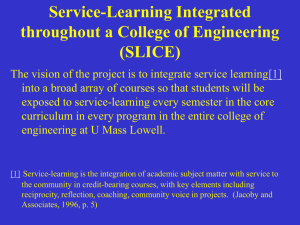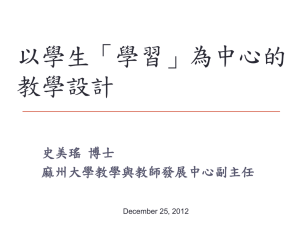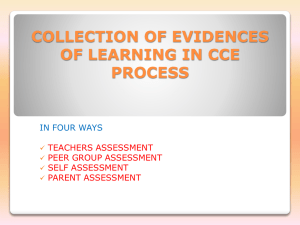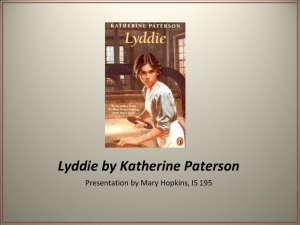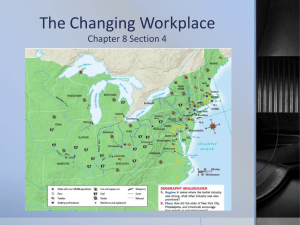Indicators of Community-University Engagement
advertisement
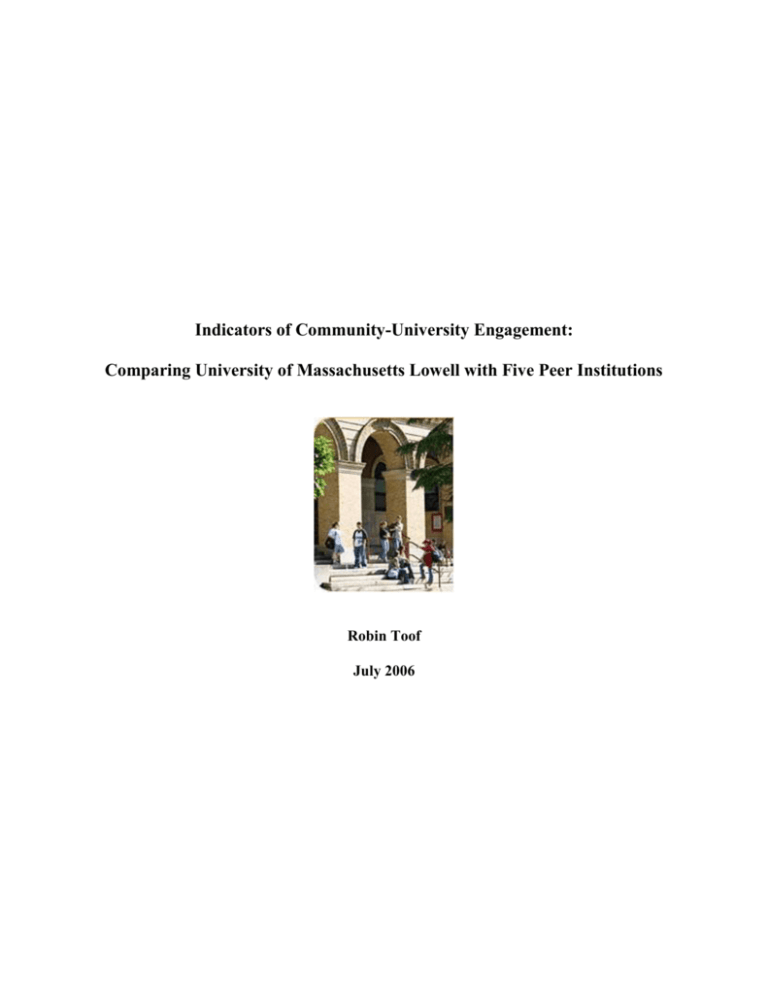
Indicators of Community-University Engagement: Comparing University of Massachusetts Lowell with Five Peer Institutions Robin Toof July 2006 Indicators of Community-University Engagement: Comparing University of Massachusetts Lowell with Five Peer Institutions Background Community-University Engagement Increasingly, institutions of higher education are being called upon to work in collaboration with communities to solve problems, build capacity and contribute to the economic and social development of regions (Boyte & Kari, 2000; Lerner & Simon, 1998). This call to action is not new. Since colonial times, there has been a connection among American higher education teaching, research, and service (Boyer, 1996; Schneider, 2000; Sullivan, 2000). The Morrill Acts of 1862 and 1890 established the land grant colleges that were to broaden educational opportunities beyond just the wealthy and improve the lives of those working in agriculture and industry through education and practical research (Boyte & Kari, 2000; Thomas, 2000). During World War II universities served the nation’s defense through applied research that resulted in (for good or for bad) the atomic bomb (Freeland, 1997), submarine warfare technology and an early mechanical computer (Blanpied, 1998). Then, the G.I. Bill served to expand higher education to broad sections of society, enlarging the middle class and spreading democratic ideals (Sullivan, 2000). Later, during the cold war, universities were integral in the development of other defense related and computer technologies that have become ubiquitous in our nation (Sullivan, 2000). In recent decades, these direct connections to solving societal problems have waned, and have been replaced with “instrumental individualism” (Sullivan, 2000, p. 21). “[T]he academy exists to research and disseminate knowledge and skills as tools for economic development and the upward mobility of individuals” (p. 21). The institution of higher education has increasingly come to be seen as elite, exclusive and largely out of touch with real world application (Boyer, 1996; Hollander & Hartley, 2000). UML Community Engagement Indicators Peer Analysis 2 As societal problems have grown and become more complicated and as higher education costs have increased, external constituents—including local and federal governments, institutional governing and coordinating boards, employers, parents and students, and communities—have begun to pressure institutions of higher education to become more accountable and to work towards the common good (Boyer, 1990; Duderstadt, 2000; Guskin, 1996; Kellogg President’s Commission, 1999). Institutions of higher education are increasingly expected to better prepare students for work, adjust research agendas to work on solving real societal problems and provide service to the communities where they are located (American Association of State Colleges and Universities, 2005). They “must be wholehearted participants in the life of their surrounding community” (Hollander & Hartley, 2000, p. 356). Civic participation by higher education institutions is much more than providing and applying knowledge and expertise to local problems. It calls for a shift in what is done both on campus and off. Externally, universities are entering into partnerships to work with other organizations in solving identified problems. Ideally, these partnerships result in sustained relationships in which the entities share resources and a stake in the success of the process and outcome. Each also shares power, leadership and decision-making (University of Massachusetts Lowell Community-University Partnerships Task Force Report, 2005). Crucially, the institution in these partnerships should come from the point of view of being “jointly responsible” for making changes along with the community rather than being the provider of all solutions (Braskamp & Wergin, 1998). Within these partnerships, universities are working with, rather than for, the community partner and there is an element of shared learning (Lerner & Simon, 1998). UML Community Engagement Indicators Peer Analysis 3 Internally, many universities are developing outreach missions and have established interdisciplinary outreach centers, community service offices, and broader extension programs (Thomas, 2000). However, Thomas (2000) stated that in order for this work to move beyond the margins and be sustainable core elements of an institution, other strategies will be needed as well. These include: leadership at all levels of the institution, not just the top or the middle; validation of community work through the faculty promotion and tenure process; genuine shared responsibility by the institution and community; projects that are responsive and flexible to real community-identified needs; institutional support in the form of funding, structure, development, and publicity; and interdisciplinary collaboration. Much of this requires a transformation of culture or a shift in paradigm within an institution of higher education. Forrant and Silka (1999) stress the importance of involving institutions of higher education in problem solving partnerships and collaborations and at the same time providing relevant meaningful learning experiences for students. Engaging students in the process is a learning opportunity that shows the importance of “community collaboration, knowledge integration, human diversity and contextual variation” (Lerner & Simon, 1998, p. 18). Community engagement may take many forms and provide avenues for rich collaboration providing students with integrated learning experiences. Community Engagement at the University of Massachusetts Lowell Community involvement is not new to UMass Lowell. There is a rich history of engagement. Linda Silka, Special Assistant to the Provost on Community Outreach and Partnerships put together the milestones timeline below which begins when Lowell State College merged with Lowell Technical Institute to form the University of Lowell in 1974 which then became UMass Lowell in 1991. The events listed are not exhaustive. UML Community Engagement Indicators Peer Analysis 4 UMass Lowell Community Engagement Milestones 1974 1980 1983 1991 1994 1995 1997 1997 1998 1998 2000 2000 2000 2001 2001 2001 2003 2003 University of Lowell established (from Lowell State and Lowell Tech) Graduate Program in Community Social Psychology established to help train social service and human service leaders and providers ULowell sets up university-wide committee to address scholarship (teaching, research, and service) and how the three can be integrated ULowell Becomes UMass Lowell. The Tsongas Industrial History Center established. The Center is a national model for how university and national parks can collaborate to use the community as an experiential classroom. Center for Family, Work, and Community established Department of Work Environment established Three Year Funding from HUD’s Office of University Partnerships received to set up UML Community Outreach Partnership Center; Advisory Board created to support this work; University in the City Scholars program begun Annual Summer Research Projects begun addressing community needs for research and involving high school-graduate student teams University of Massachusetts begins “Outstanding Professional Service” award for each campus Intro to Engineering Graduate Course for teachers established. Teachers from around the region are trained to integrate engineering design and applied science activities into the schools. DESIGNCAMP established. As of 2006, this summer science and engineering program for middle & high school students (gr. 5 – 11) consists of 15 different workshop programs serving 500 students. Department of Regional Economic and Social Development established UML carries out Millennium Breakfasts to identify regional expectations for UML Two Year “New Directions” funding from HUD’s Office of University Partnerships received to institutionalize work of UML Community Outreach Partnership Center Community Software Lab provides no-cost and advertising free email, web hosting, and other Internet services to non-profit organizations. UMass Lowell is one of ten national sites for 2001 to join the National String Project Consortium organized by ASTA (American String Teachers Association) with NSOA (National School Orchestra Association). The String Project offers violin, viola, cello, and bass instruction to elementary students in the Lowell Public Schools. The students attend classes twice a week on campus and are taught by Music Department faculty and undergraduate string majors. DESIGNLAB afterschool program started. After school science and engineering workshops are taught on campus to students from 2 Lowell middle schools. Also, several training workshops have taught 20 area middle school teachers to run these programs in their own school. Assistive Technology Design Fair (ATDF) established. This semester-long UML Community Engagement Indicators Peer Analysis 5 2004 2004 2004 2005 2005 2005 2005 2005 2005 2006 event challenges teams of high school students to find disabled, elderly or special needs folks in their schools and communities who have a problem that can be solved with technology. Student teams present prototypes of their solutions at an annual design fair in the month of May. UML Taskforce on Community Outreach and Partnership created to identify gaps in outreach UML appoints Special Assistant to the Provost for Community Outreach and Partnerships Green Chemistry department established UML appoints Director of Community Relations UML Transformation process begins aimed at identifying ways UML can improve programs and engagement College of Engineering receives funding from the National Science Foundation for Project Slice to set up Service Learning links to engineering courses UML establishes partnership with Stoklosa and Bartlett Schools to bring all parts of university into educational partnership School of Health and Environment hires two consultants (Lenore Azaroff and Gretchen Latowsky) to build partnerships between school and community UML joins Campus Compact and Community-Campus Partnerships for Health UML establishes Community Clearinghouse with Partners UMass Lowell Transformation Plan. As one of the first steps in a larger strategic transformation process, the Chancellor of the University of Massachusetts Lowell, in the summer of 2004, announced the formation of several task forces, one being the Task Force on a Strategic Plan for Community-University Partnerships. UMass Lowell shows potential in “becoming a nationally recognized innovator in developing and maintaining such partnerships” that are created to identify problems and develop solutions. The 24 member Task Force, consisting of approximately half faculty and half staff (including administration), was called on to identify the kinds of successful partnerships that already exist on campus and cull the gaps and challenges faced in strengthening partnerships throughout the region. They then developed recommendations to enhance the University’s partnership capabilities. These recommendations are based on utilizing existing “building blocks” at the university and include, among other UML Community Engagement Indicators Peer Analysis 6 proposals, creating and sustaining a community-university council dedicated to coordinating and supporting outreach and partnerships. Currently, the Transformation Plan has evolved from task force reports to the establishment of a Steering Committee of Deans and upper administration and 10 implementation teams which includes a Community Engagement Team. This team is charged with making the recommendations mentioned above come to life. UMass Lowell Community-University Advisory Board. This board (CUAB) was first established several years ago under UMass Lowell’s HUD-funded Community Outreach Partnership Center. UMass Lowell had previously created an “Industry Advisory Board” made up of representatives from private businesses that helped UMass Lowell increase its understanding of how it could contribute to the development and enhancement of regional economic development. Discussions between university and community representatives pointed to the importance of also having the University administration increase their awareness about community-university partnerships beyond a business focus. The CUAB is now comprised of approximately 20 representatives of local agencies and organizations, community residents, and university faculty and staff. Its primary goal is to provide feedback and direction to the university in areas that affect the community and their partnerships with the university. It is a mechanism to institutionalize the University’s commitment to regional economic and social development while engaging students, faculty and staff in applied community research and action. Members of the board are important players in continuing and strengthening partnerships as well as initiated innovative work in the community and university (Center for Family, Work and Community 2004-2005 Annual Report). UML Community Engagement Indicators Peer Analysis 7 The idea of comparing UMass Lowell to its peer institutions in regards to community involvement and partnerships was born out of a conversation at a CUAB meeting. Board members expressed their belief that UMass Lowell’s community involvement was a signature area that should be highlighted as much as other areas of which the university is on the forefront. It was suggested that comparative criteria be developed to investigate how UMass Lowell stands next to five peer institutions on these indicators. The following section details the procedures for choosing the indicators, obtaining the data and the meaning of the results. Indicator Project Overview This study first involved establishing and choosing potential indicators of the extent and quality of community-university engagement that could be gathered from UMass Lowell and its peer institutions. A peer analysis of five institutions based on these indicators was conducted to provide a barometer on where UMass Lowell stands in relation to these other institutions. The final report will then be presented to the Community-University Advisory Board, the Special Assistant to the Provost on Community Outreach and Partnerships and the Community Engagement Transformation Team. Peer Institutions The UMass Lowell has five peer institutions to which it compares itself. They were chosen by the administration from all public institutions that are doctoral intensive as defined by the Carnegie Foundation (www.carnegiefoundation.org); have accredited programs in engineering, business, nursing, education and art or music; do not have a medical school, law school or veterinary medicine; and have head counts between 50% and 150% of the UMass Lowell headcount. This vetting produced a list of seven institutions from which two more were UML Community Engagement Indicators Peer Analysis 8 eliminated for large differences between the number of undergraduate degrees granted or mission related reasons. The remaining institutions are listed below along with 2000 Census Data (www.census.gov) and school enrollment data from each schools website. Idaho State University is located in Pocatello, Idaho, population 53,000. The racial break down is 92% white, almost .7% African American, 1.3% Native American, 1.1% Asian, and almost 5% Hispanic or Latino. Median household income is $34,326 with 15.4% below the poverty level. Total Fall 2005 enrollment was 12,000 undergraduate students, 2,000 graduate students totaling 14,000 (www.isu.edu). Montana State University is located in Bozeman, Montana population 25,000. This small city is about 94% white and the median income of $32,000 is below the state average. Total enrollment for 2005 Fall semester was 10,842 undergraduates and 1,408 graduate students totaling 12,250 (www.montana.edu). Oakland University (Michigan) is located in Rochester, Michigan, total population 10,467 with 92% white and a median income of $65,000. Enrollment in Fall 2005 was 13,449 undergraduate students and 3,891 graduate students totaling 17,340 (www.oakland.edu). University of Louisiana Lafayette is located in Lafayette, Louisiana, population 246,000. The racial breakdown is 68% white, 28% African American, 1.4% Asian, almost 2% Hispanic or Latino. Median household income is $39,996 and 16.3% live below the poverty level. Total 2005 Fall enrollment was 15,564 undergraduates and 1,511 graduate students totaling 17,075 (www.louisiana.edu). Wichita State University is located in the largest urban setting in Kansas. Its total population is estimated at 344,284 with 75% white, 11% African American, and almost 10% Hispanic. The medain household income is $39,939. WSU Fall 2005 undergraduate enrollment was 11,139 and graduate enrollment 2,937 totaling 14,076 students (www.wichita.edu). University of Massachusetts Lowell is located in the midsize city of Lowell population 105,000 with 69% white, 16.5% Asian, 4% African American and 14% Hispanic or Latino. The median household income is $39,192 and 16.8% live below the povery level. Total Fall 2005 semester enrollment was 6,178 undergraduates, 1,921 graduate students and 2,567 continuing education totaling 10,666 (www.uml.edu). The 2003 University of Massachusetts Lowell Blue Book gives further details on the screening sources. UML Community Engagement Indicators Peer Analysis 9 Typically, indicator data is compared in areas of academic quality, access and affordability, financial health, student success and satisfaction and service to Massachusetts. The latter indicator is measured by percent of graduates who live in Massachusetts, rate of growth of distance education enrollments, number of patents and license income (University of Massachusetts Lowell 2002 Report on Annual Indicators, April, 2002). Our Community-University Engagement Indicators The process of teasing out the indicators began with reviewing literature on communityuniversity partnerships and engagement and gathering data through brainstorm sessions with the Community-University Advisory Board and the Chair of the Community Outreach Transformation Team who is also the Special Assistant to the Provost on Community Outreach and Partnerships. This initial set of indicators was compared to the Campus Compact Indicators of Engagement Project (www.campuscompact.org/ indicators/indicators-MSI.html) and then refined. Feedback on the refined list was obtained from key transformation team and board members and further revised. Additionally, indicators were also chosen based on availability. Our community partners had found it difficult to know where first to call at a large university comprised of many loosely coupled departments and research centers. They typically conducted web researches to locate potential partners. Thus, some excellent indicators that were identified were not included because the data were not found on the websites (i.e., public opinion, neighborhood revitalization, job creation, dollars expended in the community, reduction in problems, number of requests for assistance and percent follow thru, articles in community publications, students starting businesses, regional development, sustainable development, and funding related to community partnerships). UML Community Engagement Indicators Peer Analysis 10 The indicators chosen for this study were sorted into four categories—administration, communication, service learning and outreach, and “community voice” (www.campuscompact.org). Under the administration category there are four indicators: mission statement language, a named, high-level administrator with community partnerships/engagement as their responsibility, promotion and tenure language, and interdisciplinary approaches such as departments or courses. The communication category has three indicators: homepage language, articles in the internal newsletter, and partnership related publications or reports. There are eight indicators in the service-learning and outreach category: a service learning and outreach office or structure, evidence of practica or internships, course with service-learning, K-12 linkages, other service-related activity, partnerships, service related awards for students and faculty, and Campus Compact membership. The community voice category has two indicators: community representation on university committees or boards and evidence of public dialogue. The table below lists the indicators, key terms or words used to find the data and the rating system applied in order to make comparisons between schools. Community Engagement Indicators with Key Terms and Rating System Indicator Name Mission Statement High-Level Administrator Promotion and Tenure Policy Administration Key Terms/Words/Phrases public service, collaboration with others, regional development, outreach, civic engagement In title of administratorCommunity Partnerships, Community Outreach civic engagement, community-based teaching and research, professional service, public work, service UML Community Engagement Indicators Peer Analysis Rating System 1 pt = key term mentioned 2 pts = service or engagement is defined beyond mention 3 pts = further fleshed out, defined 0 pt = no 1 pt = yes 1 pt = short mention or mentioned only in one department 2 pts = mentioned plus defined 3 pts = further fleshed out, more definition 11 Interdisciplinary Approaches Interdisciplinary, multidisciplinary, interdepartmental, co-listed 1 pt = little mention, no site, few courses 2 pts = some interdisciplinary courses, studies, some centers and sites 3 pts = high mention, courses, training support Communication (internal and external) Indicator Name Key Terms/Words/Phrases Rating System Homepage Language Link on home page to 0 pt = none community partnerships/ .5 pt = yes, but imbedded involvement/engagement 1 pt = yes (more than restaurants and parks), community clearinghouse Articles in Institutional References to community 1 pt = 0-5% “Newspaper” organizations, regional 2 pts = 6-10% development, capacity 3 pts = 11-15+% building, partnerships Number of articles highlighting such work SeptDec 2005 Partnership Publications and Community, partnerships, 0 pt = none Reports service, collaboration (not 1 pt = 1 article on enews industry partner specific), 2 pts = various publications/ publications reports 3 pts = Publication specific top partnerships Service, Service Learning and Outreach Key Terms/Words/Phrases Rating System Clearing house, Coordinator 0 pt = none or Director, training for 1 pt = something but not clear faculty, office or department 2 pts = clear structure, office with focus on service learning, forms, procedures, mentoring for faculty, grants for curriculum development, reduced teaching loads, travel grants for conferences, flex schedules Practica, Internships practicum(a), internships, 1 pt = little practical training 2 pts = some 3 pts = bunch Courses with Service Learning Service Learning, experiential 0 pt = none Indicator Name Structure UML Community Engagement Indicators Peer Analysis 12 Component (other than practica or internships) K-12 Linkages other than Practica or Internships learning, learn and serve, civic engagement, community placement K-12, school to college Other Service/Outreach service club, volunteer club, service related student events/activities, course related service, community participation Partnerships Partnerships, collaboration, community/civic engagement Service Related Student Perks service awards, scholarships Member Campus Compact Campus Compact, also looked on Campus Compact website 1 pt = little 2 pts = some 3 pts = bunch 1 pt = little 2 pts = some 3 pts = bunch 1 pt = little (only service projects) 2 pts = some (long term projects) 3 pts = bunch (many long term projects) 1 pt = little 2 pts = some 3 pts = bunch 0 pt = none 1 pt = one 2 pts = both faculty and student 0 pt = no 1 pt = yes “Community Voice” (www.campuscompact.org) Indicator Name Key Terms/Words/Phrases Rating System Community Representation on Community Advisory Board, 0 pt = no University Committees Steering Committee, 1 pt = yes Community Council, community representative, Community Board, Community reps on boards or committees “Public Dialogue” facilitate or host strategic 0 pt = none found (www.campuscompact.org) planning, stakeholders from 1 pt = little the community, public 2 pts = some dialogue, avenue for 3 pts = bunch community feedback Results When evidence was found under each indicator, it was documented on research notes taken for each university. These notes can be found in the appendix. The table below shows the maximum points available for each category of indicators, the points given to each university for each indicator, subtotals and totals. The final point tally, although numeric, should not be UML Community Engagement Indicators Peer Analysis 13 construed as completely objective. To maintain as much objectivity as possible, assignment of points was done independently by two researchers and discrepancies were discussed until there was consensus on the point value. Point Tally of Indicators of Community-University Engagement Indicator UMass Lowell Idaho State Montana State Bozeman Oakland Univ Michigan Univ of Louisiana Lafayette Wichita State Kansas Administration (max = 10) Mission Statement 2 2 2 1 2 3 1 0 0 0 0 0 2 1 1 3 1 1 2 2 2 1 2 3 subtotal 7 5 5 5 5 7 Indicator UMass Lowell Idaho State Montana State Bozeman Oakland Univ Michigan Univ of Louisiana Lafayette Wichita State Kansas Communication (max = 7) Homepage language .5 0 1 1 0 .5 2 3 3 2 3 3 1 = Part of sentence 2 = Service if defined 3 = Further explained Titled Administrator 0 = no 1 = yes Promo and Tenure Policy 1 = Short mention or in one dept only 2 = Defined/explained 3 = Explained more Interdisciplinary 1 = Mention if Inter, few courses 2 = Mention of courses, studies, site, centers 3 = Extensive mention of courses, site, training, support 0 = no .5 = yes but imbedded 1 = yes Articles in Inst Publication 1 = 0-5% 2 = 6-10% 3 = 11+ % UML Community Engagement Indicators Peer Analysis 14 Partnership Publications 2 0 2 1 0 3 3 6 4 3 6.5 UMass Lowell Idaho State Montana State Bozeman Oakland Univ Michigan Univ of Louisiana Lafayette Wichita State Kansas 1 1 2 0 0 1 3 2 3 2 2 2 3 1 2 2 0 2 3 3 3 2 3 3 3 2 2 2 3 3 3 2 3 2 3 3 2 0 2 1 0 1 1 0 1 0 1 0 0 = none 1 = one article or enews 2 = various publications/reports 3 = Publication specific subtotal 4.5 Indicator Service, Service Learning and Outreach (max = 20) SL Structure 0 = none 1 = something- not too clear 2 = clear structure/office Practica/Internships 1 = little 2 = some 3 = bunch SL Courses 0 = none 1 = little 2 = some 3 = bunch K-12 Linkages 1 = little 2 = some 3 = bunch Other Service/Outreach 1 = little- short term 2 = some- long term 3 = bunch- long term Partnerships 1 = little 2 = some 3 = bunch Service Perks 0 = none 1 = one 2 = faculty & student Member Campus Compact 0 = no 1 = yes UML Community Engagement Indicators Peer Analysis 15 subtotal 19 Indicator Community Voice (max = 4) Committees/Boards 11 20 11 12 15 UMass Lowell Idaho State Montana State Bozeman Oakland Univ Michigan Univ of Louisiana Lafayette Wichita State Kansas 1 1 1 0 0 0 3 0 2 0 3 2 1 20 3 34 0 20 3 23 2 30.5 0 = no 1 = yes Public Dialogue 0 = none found 1 = little 2 = some 3 = bunch subtotal 4 TOTAL (max = 41) 34.5 AVERAGE 34.5 (84%) UML Community Engagement Indicators Peer Analysis 25.5 (62%) 16 The point totals were then standardized to percentages of the totals for each category. The scores for the peer institutions were aggregated and compared to the UMass Lowell scores. UMass Lowell received the highest percentage of points in each of the four categories except communication where it was equal to the aggregate peer score. The overall percentage for UMass Lowell was 84% as compared to 62% for all others. This is a difference of 26%. Community Engagement Indicators Scores by Category 100 100 95 90 84 80 70 69 70 64 64 62 60 54 50 45 40 30 20 10 0 Admin Comm Srvc Lrng UMass Lowell Cmnty Voice Overall Peer Average The following four tables breakdown this information by school and by indicator category. UML Community Engagement Indicators Peer Analysis 17 Administration Related Indicators 100 90 80 70 70 70 60 50 50 50 50 Idaho Montana Oakland Louisiana 50 40 30 20 10 0 UMass Lowell Wichita Both UMass Lowell and Wichita received 70% of the total points available under the administration indicator category. The remaining four schools received 50% of the total. This category includes: mission statement language, a named high-level administrator with community partnerships/engagement as their responsibility, promotion and tenure language, and interdisciplinary approaches such as departments or courses. UML Community Engagement Indicators Peer Analysis 18 Communication Related Indicators 100 93 90 86 80 70 64 60 57 50 43 43 40 30 20 10 0 UMass Lowell Idaho Montana Oakland Louisiana Wichita The scores within the communication indicator category range from 43% at Idaho and Louisiana to 93% at Wichita. UMass Lowell received the third highest percentage (64%). This category includes: homepage language, articles in the internal newsletter, and partnership related publications or reports. UML Community Engagement Indicators Peer Analysis 19 Service Learning and Outreach Related Indicators 100 100 95 90 80 75 70 60 60 55 55 50 40 30 20 10 0 UMass Lowell Idaho Montana Oakland Louisiana Wichita The scores for the service learning and outreach indicator category ranged from 55% at Idaho and Oakland to 100% at Montana. UMass Lowell received 95%, the second highest. This category includes: a service learning and outreach office or structure, evidence of practica or internships, courses with service-learning, K-12 linkages, other service-related activity, partnerships, service related awards for students and faculty, and Campus Compact membership. UML Community Engagement Indicators Peer Analysis 20 Community Voice Related Indicators 100 100 90 80 75 75 70 60 50 50 40 30 25 20 10 0 0 UMass Lowell Idaho Montana Oakland Louisiana Wichita The scores for the community voice indicator category range from 0% at Oakland to 100% at UMass Lowell. This category includes: community representation on university committees or boards and evidence of public dialogue. UML Community Engagement Indicators Peer Analysis 21 Summary and Conclusion The University of Massachusetts Lowell is meeting head-on the renewed called to action for Universities to work in collaboration with communities to help solve real problems. UMass Lowell’s commitment through many endeavors such as the Center for Family, Work and Community, the Community University Advisory Board, the Community Engagement Transformation Team, Project Slice, school year and summer youth programs and service learning courses across the campus are evidence of a culture of engagement. This has been further verified by this peer analysis which has indicated an overall 26% higher score than the aggregated peer score. UMass Lowell scored particularly high on indicators in the service learning and outreach and community voice categories. While there is no university –wide formal structure to support service learning or outreach efforts, many departments have practicum or service learning requirements as a part of the program curriculum. It was also not difficult to find instances of the community being invited into dialogues and forums of public interest. Both the administration and communication categories of indicators produced on average low scores for not only UMass Lowell, but also the other five institutions. This could indicate some areas for improvement in stronger mission or promotion and tenure language specific to service/engagement. Also, downloadable community-friendly documents, reports or newsletters that provide examples of institutional engagement can help others grasp the kinds of resources that might be available. Finally, having a clear way on a homepage for community groups or individuals to find what they are looking for within a complex university system is important. While not on the homepage, UMass Lowell individual schools or colleges pages have a link UML Community Engagement Indicators Peer Analysis 22 called “In the Community” which explains their community engagement mission and in some cases provides links to departments and their projects. Several next steps will be taken to disseminate and encourage conversation about this community engagement indicators study. Results will be presented to key members of the University administration, the Special Assistant to the Provost on Community Outreach and Partnerships, the Community University Advisory Board and the website redesign personnel. Recommendations for avenues for increased engagement will be generated as well as ways to effectively promote and highlight better what is already happening. UML Community Engagement Indicators Peer Analysis 23 References American Association of State Colleges and Universities. (2005). Renewing the promise: The public’s universities in a transforming world. Washington, DC: AASCU. Blanpied, W. A. (1998). Inventing US science policy. Physic Today, 51(2), 34-40. Retrieved November 30, 2004, from http://www.nsf.gov/od/lpa/nsf50/blanpied.htm Boyer, E. L. (1990). Scholarship reconsidered: Priorities of the professoriate. Lawrenceville, NJ: Princeton University Press. Boyer, E. L. (1996). The scholarship of engagement. Journal of Public Service & Outreach, 1, 1, 11-20. Boyt, H. C. & Kari, N. N. (2000). Renewing the democratic spirit in American colleges and universities: Higher education as public work. In T. Ehrlich (Ed.), Civic responsibility and higher education (pp. 37-59). Westport, CN: The American Council on Education and Oryx Press. Braskamp, L. A. & Wergin, J. F. (1998). Forming new social partnership. In W. G. Tierney (Ed.), The responsive university: Restructuring for high performance (pp. 62-91). Baltimore, MD: The Johns Hopkins University Press. Duderstadt, J. J. (2000). A university for the 21st century. Ann Arbor, MI: The University of Michigan Press. Forrant, R. & Silka, L. (1999, February). Thinking and doing—doing and thinking. American Behavioral Scientist, 42, 5, 814-827. Freeland, R. M. (1997). The world transformed: A golden age for American universities, 19451970. In L. Goodchild & H. Wechsler (Eds.), The history of higher education (pp. 587-607). Boston, MA: Pearson Custom Publishing. UML Community Engagement Indicators Peer Analysis 24 Guskin, A. E. (1996, July/August). Facing the future. Change, 28, 4, 26-38. Hollander, E. & Hartley, M. (2000). Civic renewal in higher education: The state of the movement and the need for a national network. In T. Ehrlich (Ed.), Civic responsibility and higher education (pp. 345-366). Westport, CN: The American Council on Education and Oryx Press. Kellogg President’s Commission. (1999, February). Returning to our roots: The engaged institution. Washington, DC: National Association of State Universities and Land-Grant Colleges. Lerner R. M. & Simon, L. K. (Eds.). (1998). University-Community collaborations for the twenty-first century. New York, NY: Garland Publishing, Inc. Schneider, C. G. (2000). Educational missions and civic responsibility toward the engaged academy. In T. Ehrlich (Ed.), Civic responsibility and higher education (pp. 98-123). Westport, CN: The American Council on Education and Oryx Press. Sullivan, W. M. (2000). Institutional identity and social responsibility in higher education. In T. Ehrlich (Ed.), Civic responsibility and higher education (pp. 19-36). Westport, CN: The American Council on Education and Oryx Press. Thomas, N. L. (2000). The college and university as citizen. In T. Ehrlich (Ed.), Civic responsibility and higher education (pp. 63-97). Westport, CN: The American Council on Education and Oryx Press. UML Community Engagement Indicators Peer Analysis 25

